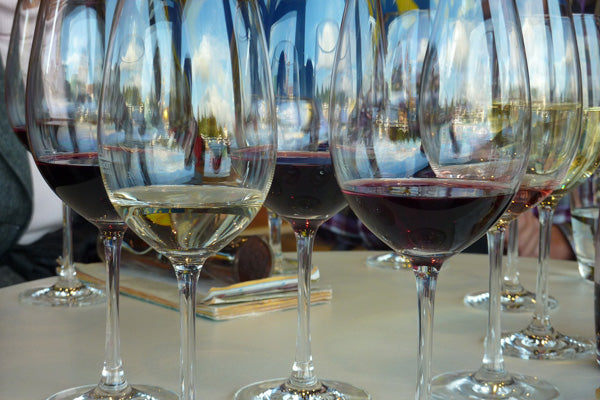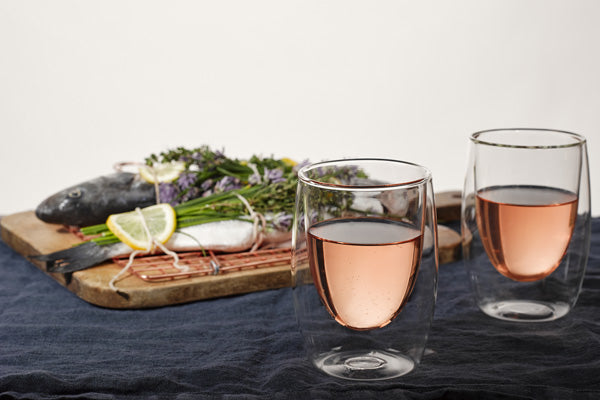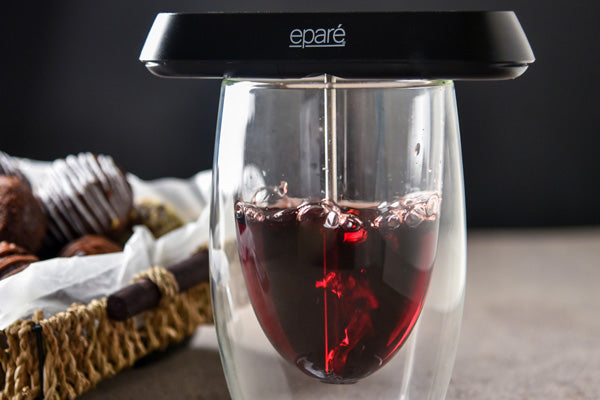Sure you love wine, and maybe you have toured some wineries. Maybe you have your own wine cabinet, hopefully not under the kitchen sink. But are you drinking it the right way? Don’t worry, this is not an article about how you must first swirl the glass, then stick your nose in it and smell, then swish it around your mouth before swallowing. We are not that uptight. However, we have done a lot of wine research ourselves and there are some things to consider when drinking, and serving, wine that will enhance the experience. After all we want to make sure you are enjoying wine to its fullest potential, and no we don’t mean finishing the bottle and opening another. That being said, we don’t judge.
Look at the extra Large Wine Glasses I bought!
Believe it or not, the kind of glass and even the size of glass you drink your wine out of can have an effect on the taste. First of all, bigger is not really better, so stick with a normal sized glass. There are a million options when it comes to wine glasses and while it may be over thinking it to go buy a different glass for every single type of wine, you may want to consider the idea of evaporation. Yeah it’s pretty technical, simply put, as the wine sits in the glass and you drink it, it evaporates slowly and ethanol vapors exit the glass. So, the wine aromas are exiting the glass and entering your nose, and these effect the way it tastes. The idea here is selecting a glass that highlights certain aroma compounds for a particular style of wine.
Some rules to go by:
White wines are typically served in smaller bowled glasses.
- Preserve floral aromas
- Maintain cooler temperature
- Delivers more aromas (even at cooler temperatures) due to proximity to nose
Red wines are typically served in larger bowled glasses
- Delivers more aroma compounds vs. the burn of ethanol from being farther from nose
- Larger surface area to let ethanol evaporate
- Wider opening makes wines taste smoother

Temperature Matters!
The reality is all wine will taste better slightly chilled. I know everyone has told you, “Red wine should be room temperature, white wine should be refrigerated, and Champagne and sparkling wines must be served on ice!” They weren’t wrong, they just weren’t completely right. Going back to our idea of evaporation and those aroma compounds burning off…Temperature no doubt affects this. Some wines are more delicate than others and certain compounds evaporate more quickly. As a result even red wine should be chilled slightly. Here is a good guide for temperature:
- RED WINE tastes better when served slightly below room temperature from 53-69 °F (light red wines like Pinot Noir taste better at the cooler end of the spectrum)
- WHITE WINE tastes great from about 44 – 57 °F. (zesty whites on the cool side and oak-aged whites on the warm side)
- SPARKLING WINE Affordable sparklers do great at 38 °F – 45 °F (serve high-quality Champagne and sparkling wines at white wine temperatures)

What's the point of Swirling your wine?
If you recently visited a winery or have started to flirt with the idea of “getting into wine” you have no doubt heard about aerating wine or “letting it breathe and/or open up”. Maybe you are a long time wine drinker and you already know of the benefits of aeration, and you even own a decanter. Either way, we wanted to discuss a few things about aeration and possibly dispel some of the previously accepted “facts” when it comes to this topic.
Aerating can help the flavor of any wine. Traditionally, aerating was reserved for young complex reds with a heavy tannin base, or old aged wines with a heavy amount of sediment. These wines certainly benefit from aeration, but they aren’t the only ones. Any wine can benefit from this process; you just have to be careful not to do too much or too little. Now we go back to the idea of evaporation. Aeration can help, to evaporate some of the more undesirable compounds that we discussed earlier. It also can help to expose some of the more floral and delicate aromas and give certain young wines a more “aged” taste.
With that being said; What is the difference between decanters, pour through aerators, and active aerators? How much time do you have?
Decanters: These take the longest. Decanters are designed for older wines with sediments that need to settle, the shape of the decanter is meant to leave the sediment in the decanter and not in the glass. Its the slowest style of oxidizing wine so that you don't miss the sweet spot, usually swirling in your glass will still be required as the aroma doesn't open up as much.
Pour Through Aerator: These force wine through a series of chambers to introduce oxygen. Most only have one setting which does not work for all styles of wine. Once you pour it through if you didn't achieve what was required only solution is to swirl to perfection or re-pour it somehow. There are pour through aerators with adjustment dials or pour settings but again it’s hard to re-pour if you didn’t get it right on the first try.
Active Aerators: These aerators typically work in the bottle or in the glass and introduce ambient oxygen into the wine via a pump. There are manual models and battery operated models. Pros, you can adjust the amount of oxygen at your preference with much less guess work. Cons, some people may get offended of using such a new age method on an older wine. Bottom line active aerators are the easiest and fastest ways to get to a desired level.
Learn More about the Eparé Pocket Active Aerator
Additional Reference: http://winefolly.com/wine-basics-beginners-guide/
